Let our expert Maths tutors assist your child to develop their confidence and improve their school achievements in Mathematics!
The primary school years are important for students as they develop their foundational knowledge and skills in Mathematics. Our Maths lessons assist students to understand Mathematic concepts, build specific skill sets and gain confidence in their mathematical ability.
Our one-to-one and small group student to teacher ratio ensures that every student learning with us at Optimise, is being explicitly taught the skills they need to learn next.
Student progress is carefully monitored throughout each lesson, and these observations are used to plan future lessons, ensuring that the learning needs of individual students are being catered for. At Optimise Learning, teaching resources are mapped to the Australian National curriculum, so by learning with us, students are building upon what they are learning at school.
Why Do Some Students Need Mathematics Tutoring?
Even though student’s progress at different rates, they are expected to demonstrate pre-determined levels of proficiency in Mathematics, every school year. The Mathematic progression of students is assessed, then measured against the Australian National Curriculum Achievement Standards, and graded as being of an A, B, C, D or E standard.
For a variety of reasons, including those discussed below, many students perform below their potential in Mathematics at school, and receive a grade that is not indicative of their true ability.
Primary Mathematics Tutoring from Prep to Year 2
From Prep to Year 2, students are developing their foundational knowledge and skills in the areas of number, algebra, measurement, geometry, statistics and probability. If a student falls behind in Mathematics in their early years of school, research shows that it is extremely difficult for them to catch up in later years without extra assistance.
Whilst the focus of our individualised tutoring is dependent on the specific learning needs of each student, our tutoring lessons cover the full range of early Mathematical skills taught at school, including:
- Number names, numerals and quantities up to 1000.
- Skip counting forwards and backwards by 2s, 3s and 5s.
- Comparing objects using mass, length and capacity.
- Telling the time and interpreting calendars
- Using the language of direction and interpreting simple maps
- Dividing collections and shapes into halves, quarters and eighths.
- Collecting, organising and representing data to make simple references
Mathematics – Foundation
The numeracy understandings that students develop in their first year of school will form the ‘foundation’ for all of their future mathematical learning. By the end of the Foundation Year students are expected to make connections between number names, numerals and quantities up to 10. They compare objects using mass, length, capacity and connect days of the week to events. Students are all expected to demonstrate the ability to count to and from 20 and order small collections of objects.
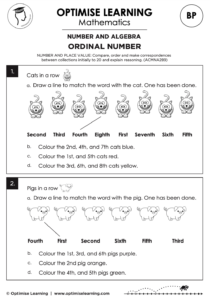
Mathematics – Year 01
In their second year of school students are consolidating and extending the numeracy understandings they gained in the Foundation Year. By the end of Year One students are expected to skip count by 2s, 5s and 10s. They demonstrate an understanding of one half and tell the time to half an hour. Students recognise Australian coins and describe 2 and 3-dimensional objects. They are expected to be able to count to and from 100 and locate numbers on a number line. Students complete simple addition and subtraction equations and order the length and capacity of objects using informal units.

Mathematics – Year 02
Students in their third year of school are continuing to consolidate and extend their early understandings of numeracy. By the end of Year Two students are expected to skip count forwards and backwards by 2s, 3s and 5s. They are introduced to multiplication and division, and describe the features of 3-dimensional objects. Students are expected to be able to count to and from 1000, and perform simple addition and subtraction calculations using a range of strategies. They demonstrate an understanding of halves, quarters and eighths and tell the time to quarter-hour.
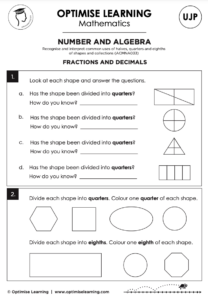
Primary Mathematics Tutoring from Year 3 to Year 6
Throughout the middle and upper years of Primary School, students are consolidating and extending their Mathematics knowledge and skills in the areas of number, algebra, measurement, geometry, statistics and probability.
Whilst the focus of our individualised lessons is dependent on the specific learning needs of each student, our tutoring lessons cover the full range of Mathematical skills taught from Year 3 to Year 6 at school. This involves developing proficiencies in a range of areas, including:
- Using a variety of strategies to solve problems that involve using the four operations to solve problems.
- Connecting three-dimensional shapes with their two-dimensional representations.
- Connecting fractions, decimals and percentages as different representations of the same number.
- Making connections between capacity and volume.
- Solving problems involving area and perimeter.
- Describing combinations of transformations.
- Solving problems using the property of angles.
- Calculating a fraction of a quantity.
- Adding, subtracting, multiplying and dividing decimals.
- Constructing prisms and pyramids.
- Locating integers and fractions on number lines.
- Locating an ordered pair in any quadrant of the Cartesian plane.
Mathematics – Year 03
By the end of Year Three students are expected to recognise the connection between addition and subtraction and solve multiplication problems. They model and represent unit fractions. Students identify symmetry and recognise angles in real situations. They count to and from 10 000 and tell the time to the nearest minute. Students measure length, capacity and mass using metric units and make models of 3-dimensional objects. The first year of NAPLAN provides insights into individual student’s progress and highlights areas that require support or extension.
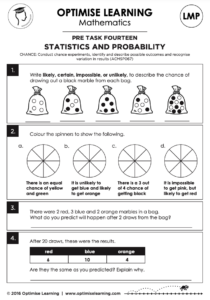
Mathematics – Year 04
By the end of Year Four students are expected to recognise the connection between multiplication and division. They recognise common equivalent fractions, locate fractions on a number line and make connections between fractions and decimals up to two decimal places. Students compare formal and informal shapes using informal units. They solve problems using time, temperature, length, shapes and objects. Students recall the times-tables and related division facts. They classify angles and create symmetrical shapes and patterns.
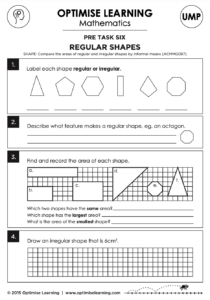
Mathematics – Year 05
By the end of Year Five students are expected to be able to identify and describe factors and multiples, and connect 3-dimensional objects with their 2-dimensional representations. They are expected to be able to describe transformations of 2-dimensional shapes, and identify line and rotational symmetry. Student order decimals and unit fractions and locate them on number lines. They add and subtract fractions with the same denominator. Students calculate the area and perimeter of rectangles, and convert between 12 and 24 hour time. They measure different angles and list the possible outcomes of experiments involving chance. The second year of NAPLAN provides insights into individual student’s progress and highlights areas that require support or extension.
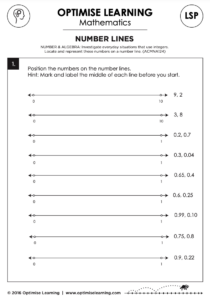
Mathematics – Year 06
By the end of their final year of primary school, students are expected to be able to describe the properties of prime, composite, square and triangular numbers, and solve problems involving all four operations. Students connect fractions, decimals and percentages, and solve problems involving the addition and subtraction of related fractions. They add, subtract, multiply and divide decimals where the result is rational. Students use the order of operations, and locate ordered pairs of numbers on the Cartesian plane. They construct simple pyramids and prisms, and describe probabilities using simple fractions, decimals and percentages. Students connect decimal representations to the metric system and choose appropriate units of measurement to perform calculations.
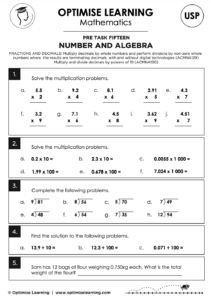
Check if Your Child Has The Appropriate Understandings and Skills In Mathematics At Their Year Level
MATHEMATICS PRE TASKS (PREP TO YEAR 6)
Optimise Learning’s Mathematics Pre Tasks for Prep to Year 6 students will enable parents to see if their child demonstrates the required understandings in number and algebra, measurement and geometry and statistics and probability at their year level.
If a student is able to complete a Pre Task independently, easily and accurately, parents can assume their child has reached the required achievement standard* in that topic. If a student needed assistance to complete the Pre Task, parents can assume their child needs to learn more in that topic, to reach the required achievement standard*.
*Achievement Standards describe the expected knowledge, understanding and skills of students at each year level. You can read more about Australian Curriculum Achievement Standards HERE.
What Our Parents & Students Have To Say
Start Optimising Your Child’s School Achievements Today!
Our academic tutoring services have assisted hundreds of students throughout Australia to develop their self-confidence, and improve their achievements at school.
Contact us to discuss your child’s learning needs and academic goals.
